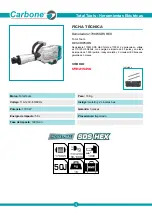
80
CHAPTER 3:
Installation and Setup
Model CRX-6.5K Probe Station
The sample stage and radiation shield stage will also start to lower in temperature after a
delay, but it is not required to wait to see these stages drop in temperature to verify
proper CCR performance.
If the CCR second stage and CCR first stage sensors do not register a drop in
temperature after 1 min of operation, refer to section 6.3.2 CCR troubleshooting. If
the steps listed there do not reveal the problem, contact a Lake Shore representative
for assistance.
3.8.4 Microscope Light
and Focus Test
Follow this procedure to ensure that the microscope focuses properly on the sample
stage. See section 2.3.6.1 for a sample of approximate focal clarity when you use the
focus aid with the Zoom 70 and Zoom 160.
1. Place a piece of sample material or sample substrate on the sample holder. We
recommend using an optical target such as the U.S.A.F. optical target for
resolution verification.
2. Install the radiation shield lid and the vacuum chamber lid (see section 4.3.5).
3. Refer to section 4.6.1 to use the microscope to image the sample.
4. If the microscope will not focus on the target, refer to section 6.3.4.
5. If the image is not oriented as desired, refer to section 6.3.4.8.
3.8.5 Testing the
Probe Arm Reach
Follow this procedure to check the probe arm reach.
1. Remove the vacuum chamber lid and radiation shield lid (section 4.3.1).
2. Use the z-axis micrometers to raise all probes up 3 mm to 4 mm above the
sample stage.
3. Slowly move one probe towards the sample stage using the x-axis hand dial.
4. Watch for interference of the probe, cable connector and blades.
5. Using the x and y-micrometers to adjust position, move the probe (it should
travel smoothly) until the probe tip reaches all sides of the specified 25 mm (1 in)
diameter probe area (see FIGURE 4-1 for probe area).
6. Retract the probe and repeat for all other probes.
Check arm reach one probe arm at a time. Retract the previously checked arm before
advancing a second arm into the sample area. Failure to comply may result in probe
tip damage.
3.8.6 Probe
Continuity Test
Follow this procedure to ensure that the probes have been installed correctly and will
transmit a signal when probing a sample. The radiation and vacuum chamber lids do
not need to be installed. This procedure should be performed whenever a probe arm
or probe has been changed.
Do not perform this test on microwave probes unless there is a specific concern. The
microwave semirigid cables and connectors seldom have continuity problems. Failure to
comply may result in probe tip damage.
1. Land each probe tip on the top surface of the grounded sample holder
2. Using a multimeter, measure continuity (resistance) between each adjacent pair
of probes.
















































